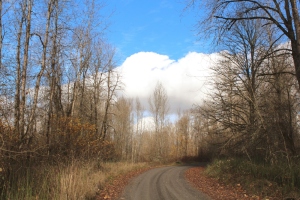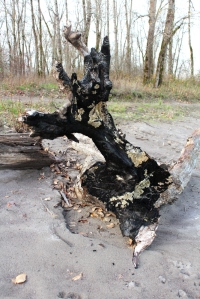By far the most common tree at the riverside beach I volunteered to keep clean is the black cottonwood (Populus trichocarpa), also known as the western poplar. A young-ish forest of these tall, lanky trees crowd up almost to the edge of the river, stopped only by the sandy beach itself. I’m used to hiking through forests of aged conifers, Douglas fir and Western hemlock and the like. The energy of these fast-growing poplars was almost frenetic in comparison (though certainly conifers can contend well in the upward race to the sun).
I spoke to the totem Black Cottonwood about this, and found that because these trees are relatively short-lived, they tend to be more “sped-up” than some others. It’s worked to their advantage in several ways, to include in competition with other plants. A stand of new cottonwoods can create a young canopy in less than decade, quickly (and literally) overshadowing smaller, slower-growing trees and shrubs.This comes at a price, of course. Black cottonwoods are, as mentioned, short-lived, averaging a lifespan of 125 years or so. Not that this is an uncommon trend in nature, of course, but we so often think of trees as being potentially ancient that it’s a bit startling to realize a black cottonwood we plant when we’re young may not outlive us by much.
And it’s a reminder to look at the effects of competition. Beneath the canopy of black cottonwoods, the forest along the beach is filled with invasive Himalayan blackberry and Scotch broom. From a self-centered perspective, these plants are doing great–they’ve edged out the competition in the undergrowth and settled themselves in firmly. Some humans are content to have a similar worldview, elbowing their way into a situation and shoving everyone else out no matter the cost. There’s nothing wrong with healthy competition, of course. It can be a good motivator to get people to create new and amazing things. But when it does damage to the overall system, whether an ecosystem or a human community, that’s cause to pause, reflect, and change the situation.
Finally, life isn’t just about racing to be the fastest or the best. I admit that I drive myself really, really hard. I have a lot of things that I’m working on and sometimes I feel overextended, stretched too thinly. I like what I create, but sometimes it can be exhausting. So I often need to remind myself to slow down and enjoy the scenery; even if I’m not as tall as a cottonwood tree, the view’s still pretty good from where I am and I oughtn’t miss it on my way up.
Black Cottonwood also pointed out that because her children grow so close to the water they’re directly affected by the pollutants therein. She told me that if I were to take root samples from the trees closest to the river, and then further away from the water, the closer ones would have absorbed more of the pollutants already found in the water. However, even the trees closer in to the island weren’t completely safe; agricultural runoff, and pollutants from the roads encircling the island also ended up in the soil and roots. She told me that in the same way it was important to monitor the toxins in my own self, physical and otherwise, and to be aware of what I take in. And, as I’ll be training later this year to test the water quality of the Columbia River along the beach, so do I need to be paying attention to what I’m absorbing.
It made me think about what I can’t help but allow into my body. Because I live in an urban environment, I’m constantly breathing in all sorts of toxins from vehicles and other sources. Most of the time it’s hard for me to consciously pay attention to it, but all it takes is walking through one cloud of exhaust or cigarette smoke to realize my respiratory system is being constantly assaulted. Even in the wilderness I’m not safe, as air pollution knows no boundaries. I can have some more control over what I choose to eat, though unfortunately I’m not at a point where I can grow my own food or afford to only buy organic, free-range food all the time. Still, I can make changes where I’m able.It’s not just physical toxins, either. Emotional and psychological toxins are everywhere. My anxiety is a pretty frequent internal source thereof, and I have to take a little time out here and there to check the outflow of stressful, anxious thoughts and get myself back to a healthier homeostasis. That doesn’t change the fact that other people can be pretty toxic, too. Sometimes it’s people being mean for the sake of being mean (or “for the lulz”, its own special brand of bullying). Other times it’s folks who have a good message to convey, but a rather ineffectively caustic manner of conveying it. These toxins, too, need to be monitored, and if possible their sources cut out of my life. Failing that, good coping skills and defenses are called for.
So it seems I have quite a bit in common with the black cottonwood trees, and much to learn from their totem. I’m curious to see where this goes as I continue making my visits to clean their habitat up on this island in the Columbia, but I’d say we’re off to a good start.
As a side note, as I was researching the black cottonwood I found out that it was the first tree to have its genome sequenced. It genome is described as “compact”, about 1/50 that of the size of a pine tree. Nothing’s jumped out at me totemically regarding that just yet, but hey–maybe something about new levels of usefulness to others, since the cottonwood is already used for lumber, fiber and the like. (Might there also be something about speaking out against being used, perhaps? We shall see.)



I love your plant essays and am glad you are able to find yourself in such good company during your volunteer work. Just a personal not that may or may not be applicable to you, but when I find a totem whose children have recently helped with scientific or medical progress there is normally a theme of “the human connection and interdependence with the rest of Nature isn’t a relic of the past, but rather an ongoing process”. It’s one of the reasons why I find totemism to be as valid today as it was in the past. We are still learning from plants, animals, and the rest of Nature and always will be.
That’s a really interesting way to frame the genetic findings! I haven’t been back to the beach since I found that out, but I’d like to ask Black Cottonwood about it next time I’m there.